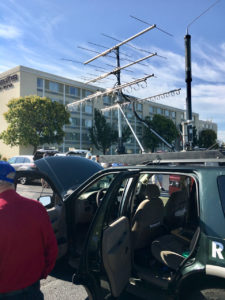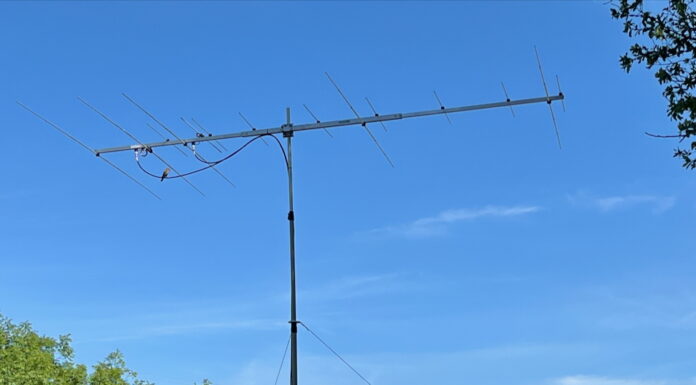 The conference began on Thursday evening with a social mixer where I met a whole range of folks, including Mike, WB0O, who happened to be born in the same small town in Nebraska where I was born. A highlight was getting a guided tour of Andrea K2EZ’s rover mobile that boggles the mind for the number of bands and the way she approaches mobile roving — making QSOs while driving across multiple grids.
The conference began on Thursday evening with a social mixer where I met a whole range of folks, including Mike, WB0O, who happened to be born in the same small town in Nebraska where I was born. A highlight was getting a guided tour of Andrea K2EZ’s rover mobile that boggles the mind for the number of bands and the way she approaches mobile roving — making QSOs while driving across multiple grids.
On Friday, I got to meet another Rover Rock Star, Wyatt, AC0RA. We’d made contact on satellites and 6 meters from his rare grid activations over the last couple of years, but this was our first face-to-face meeting. The other highlight of the morning was attending the Rover Row and the Dish Bowl. Getting deep insight into how other rovers approach the game was very interesting.
 The afternoon conference sessions were informative. Although a few were at a very high level of technical content, I still found them fascinating if only as a window into what some were doing in this space. Learning more about Larcan Amplifiers was interesting and the lunch time briefing by W9FZ and W0ZQ about their microwave rove across Nebraska headed to a solar eclipse watching site was incredible. They literally worked their way in teams across North Nebraska and South Nebraska making microwave QSOs between the teams along the way.
The afternoon conference sessions were informative. Although a few were at a very high level of technical content, I still found them fascinating if only as a window into what some were doing in this space. Learning more about Larcan Amplifiers was interesting and the lunch time briefing by W9FZ and W0ZQ about their microwave rove across Nebraska headed to a solar eclipse watching site was incredible. They literally worked their way in teams across North Nebraska and South Nebraska making microwave QSOs between the teams along the way.
Saturday’s session covered the entire day and touched on Extreme Es over water paths, the portable EME single yagi 6 meter set up in an Iowa cornfield, and Wayne Overbeck, N6NB, touching on his roving history down through the decades. The lunch briefing providing a very interesting insight into the search for Amelia Earhart’s lost plane in the Pacific.
 One of my missions during the conference was to gain insight into how to add 222 MHz to my rover. I collected lots of advice including from Steve, N2CEI, from Downeast Microwave who designed and built the transverter I’m considering. This morning it dawned on me that rather than trying multiple workarounds in trying to use my IC-9100 as the IF on 28 MHz (lowering power on 28 versus running full power on the other bands), that I’ll just deploy my IC-910H as the IF rig at 144 MHz. We’ll see how well that thought sits.
One of my missions during the conference was to gain insight into how to add 222 MHz to my rover. I collected lots of advice including from Steve, N2CEI, from Downeast Microwave who designed and built the transverter I’m considering. This morning it dawned on me that rather than trying multiple workarounds in trying to use my IC-9100 as the IF on 28 MHz (lowering power on 28 versus running full power on the other bands), that I’ll just deploy my IC-910H as the IF rig at 144 MHz. We’ll see how well that thought sits.
Previously, I’d attended the 2014 CS VHF Conference held in Austin, Texas.








